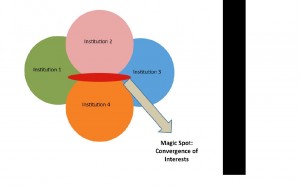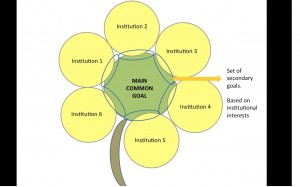Partnerships: “Magic happens in the intersection” – Part 2
Let me tell you the story about a friend from Peru, let´s call him Paul. I met Paul in a Volunteer institution (Voluntades) in Peru 8 years ago. He is one of the oldest volunteers of the group, not because of his age, but because of the number of years that he has been involved in the institution, almost 15.
The funny thing about his story was his personal motivation to start volunteering: he was chasing a girl. That was his real personal interest, which happened to converge with the interest of the institution (they needed volunteers) and the interest of the foster children that we helped, who needed friends to talk to and play with. Would you say that since Paul´s main interest was not the common goal (help the foster children) he should not have been accepted? Or would you recognize that the convergence of interest was positive for everyone? It is not like he didn’t care about the common goal, he did care, but he had another personal goal too, and the final goal for him became a means to another end.
Source: Voluntades.
Unfortunately for Paul, he didn’t get the girl he was chasing, but he became a very active volunteer, dedicating almost 10 years of Saturdays to the most needed.
The common goal: a means to another end
Is it really possible to have a common vision? In my opinion, a common vision is something that cannot exist at all. How can we expect that completely different institutions, with different reasons of existence, different motivations, interests and values can have a common vision? It is by nature impossible. It is only realistic to think and talk about convergence of interests.
If different institutions start working together towards a common goal, it is only because either in the process or in the achieving of this goal, each institution will fulfill its own interest. Each institution will get something back, and this something has nothing to do with the original goal. The common goal of a partnership is only an excuse, only a means to other ends.
No institution should get involve in a partnership only thinking about the common goal. They must all have clear what are their own interests and what they want to get back. Every institution should win something, and this something should be relevant enough for the institution to stay in the partnership and keep up with all the hard work that will be needed. If one of the members is not fulfilling their interests, the participation of that institution will not be sustainable, and therefor, the future of the whole alliance can be affected.
Source: Personal production
Clear communication and honesty
As Adam Smith once said, “individual ambition, serves the common good”. The convergence of different individual interest can contribute to achieve a common social and environmental goal.
What is the main problem with this? Institutions and individuals fail to communicate what their interests are. Maybe they feel ashamed for having other interest apart from the common goal. Maybe they don’t trust each other yet, to admit what their real objectives are. Maybe they feel that they will be judge for having the “wrong motivations” or for “taking personal advantage” out of a common goal.
The result is that most of the time, institutions hide their real motivations, and this lack of honesty is one of the main obstacles to successful partnerships.
When particular objectives are not express, the partnership becomes weak. If institutions have hidden agendas, not only the relationship becomes untruthful, and unclear, but also, their expectations may be unrealistic, and when these expectations are not met, chances are that they will feel frustrated and leave. Having stated their desired goals from the beginning, they could have realized the feasibility of their wishes and maybe had taken different choices for the benefit of all.
He have to change our way of thinking, we have to stop judging other institutional and individual interests, we have start being honest and clear, both with ourselves and with others, in order to communicate our real motivations, desires and objectives. It is not our job to judge, but to focus on that little magic spot where our interests converge, and where we become more alike.
All objectives matter: defining secondary institutional objectives
The objectives of each institution, once clearly expressed, must be recognized as part of the alliance. The partnership should define a primary goal that we all want to achieve together, and also define another list of secondary goals, that include what every institution expects to achieve as well. This goals should be included as part of the project, as part of the partnership, and they should be monitored, measured and evaluated.
Source: Personal production
There are many definitions about partnerships, but one that I like a lot is the one made by the Partnering Initiative, because it recognizes “the achieving of individual objectives.”
Defining success
What is a successful partnership then? For me, a successful partnership is not only a partnership that is able to work efficiently together and achieve the common goal. For me, a successful partnership is that where the common goal is achieved efficiently, but also, and as importantly as the first one, the specific and particular goals of all the institutions of the alliance are also met.







.png)
].gif)
.png)
].png)
].png)
].png)
.png)
].png)
.png)
